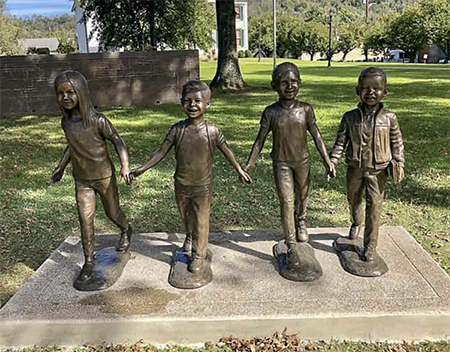Randolph Rose Collection: Creating Bronze Legacies that Stand the Test of Time
At Randolph Rose Collection in Yonkers, New York, they receive requests to create sculptural works of art in materials other than bronze but they never deviate.
“We won’t stray,” says Austin Rose, one of Randolph’s three grown sons who’s involved in helping him run the family business centered on lost-wax custom bronze statues and fountains. “Bronze stands the test of time--when it ages it becomes more beautiful and I don’t know if you can say that about other materials.”
Growing up in close proximity to Manhattan, Rose recalls visits to New York City’s Central Park and travel through Europe where he would see bronze sculptures on view that were evidence of bronze’s longevity.
Today, Rose focuses on client outreach, marketing and website development at the business his father founded in 1972. Since its inception, Randolph Rose Collection has been rooted in creating bronze sculptural works of art for homes, gardens and public spaces.
 Celebrate Diversity - Fun with Friends by Randolph Rose Collection.
Celebrate Diversity - Fun with Friends by Randolph Rose Collection.Photo courtesy of Randolph Rose Collection.
“We are a very tight-knit family,” Rose says. “We were raised in the arts with an appreciation for it and I don’t know if it’s carrying on a legacy from one generation to the next, but we all enjoy being involved in it -- I can’t imagine being involved in anything else.”
According to Rose, Randolph Rose Collection’s business has blossomed in the last several years. Since the pandemic started, for example, Rose has seen an uptick in people wanting to commission projects that have personal significance to them.
“Everyone has different things that are important to them,” he says. “We have seen projects where people want to represent our military -- veterans, soldiers that have been lost in battle -- from WWII to Vietnam to current day.”
Also in the past year, there has been an increase in parents reaching out to them who are looking to memorialize their child who passed away from an unfortunate circumstance.
“Children who really come from different walks of life,” he says. “Children that may have been underrepresented walking through life -- special needs children bound to wheelchairs -- some with incurable diseases -- some with different developmental disabilities.’
Rose says the process is very emotional and personal for families, which sometimes serves as a barrier to a sculpture of their child coming to fruition, in addition to other factors.
“It’s extremely expensive and there are barriers to entry and not every family can afford to go through with it,” he says, adding in some cases a community will do fundraising. “The money and the emotional process is really hard.”
Memorials for pets that have passed away have also been in demand. One sculpture was commissioned to memorialize a famous Labrador Retriever, Jack, from Maryland whose owner started ‘Jack’s World’ on Facebook which has over 40,000 followers. The sculpture is on view at the North Beach Maryland Boardwalk and Pier on the Chesapeake Bay in Maryland.
“We made Jack on a six foot long bench with a squirrel on the ground under the bench,” Rose says. “It’s been a real highlight celebrating the dog’s life and bringing so much pleasure to the community.”
After it was unveiled, people started posting pictures of themselves sitting with Jack on the bench using the hashtag #jackmemorial.
“They get hundreds, if not thousands, of posts all over Facebook,” Rose says. “It gets so much love and attention from the community.”
Regardless of the beloved subject, whether child or dog, the family has input during the process from start to finish that can take anywhere from eight months to a year.
“It’s important that the family can weigh in,” he says. “We will go to whatever length we need to make sure everyone is happy in clay form and then we move to casting and bronze.”
Expressing diversity through sculpture is another area of growth Rose has seen increase over the years. One of Rose’s personal favorite sculptures they created is called Celebrate Diversity which is on public view in North Carolina. It was made for a builder who requested the sculpture to represent four children of different ethnicities.
“It really started as a demand from our clients saying this is what we need to represent our community,” Rose says.
Bronze is the common denominator that positively impacts the longevity of Randolph Rose’s pieces regardless of subject matter. Rose looks forward to the pleasure a 16-foot tall statue of a horse with a knight riding atop it named Victory will bring to the Rutgers University, New Jersey, community a century down the road.
“We know, or we are hoping that 100 years from now, that sculpture will be outside that the community can rally around,” he says of the sculpture that is located outside the University’s football stadium. “It’s going to stand the test of time and it becomes an important facet of the college experience.”
Resources:
Also in this Issue:
- Art Omi: Showcasing the True Nature of Sculpture
- Randolph Rose Collection: Creating Bronze Legacies that Stand the Test of Time
- The Whimsical Wildlife Bronzes of Pokey Park
- Rare 1900s Gilded Native American Weathervane Auctioned
- Rare 19th-Century Bronze Vase Designed by Thomas Hope Discovered in Oklahoma Collection
